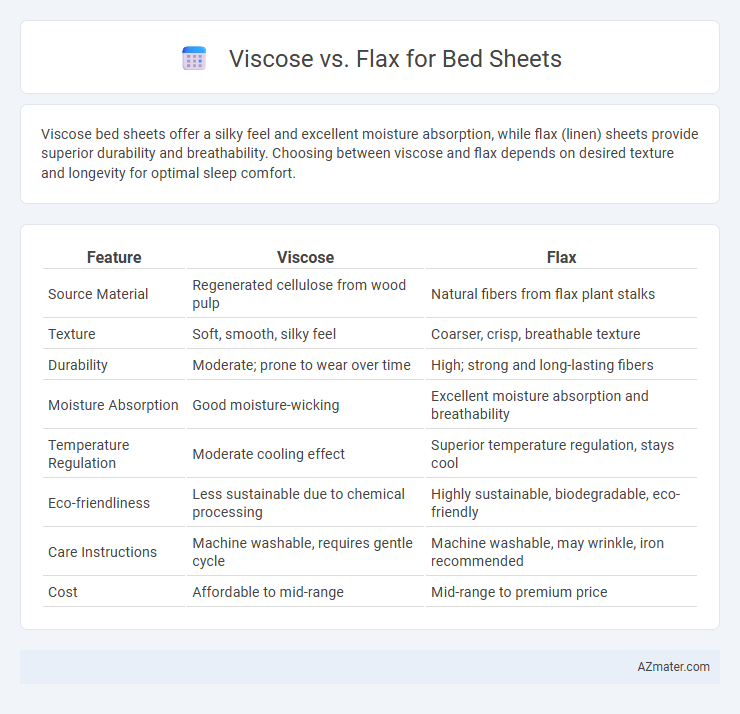Viscose bed sheets offer a silky feel and excellent moisture absorption, while flax (linen) sheets provide superior durability and breathability. Choosing between viscose and flax depends on desired texture and longevity for optimal sleep comfort.
Table of Comparison
| Feature | Viscose | Flax |
|---|---|---|
| Source Material | Regenerated cellulose from wood pulp | Natural fibers from flax plant stalks |
| Texture | Soft, smooth, silky feel | Coarser, crisp, breathable texture |
| Durability | Moderate; prone to wear over time | High; strong and long-lasting fibers |
| Moisture Absorption | Good moisture-wicking | Excellent moisture absorption and breathability |
| Temperature Regulation | Moderate cooling effect | Superior temperature regulation, stays cool |
| Eco-friendliness | Less sustainable due to chemical processing | Highly sustainable, biodegradable, eco-friendly |
| Care Instructions | Machine washable, requires gentle cycle | Machine washable, may wrinkle, iron recommended |
| Cost | Affordable to mid-range | Mid-range to premium price |
Introduction to Viscose and Flax Bed Sheets
Viscose bed sheets, made from regenerated cellulose fibers derived from wood pulp, offer a silky texture and excellent breathability, making them ideal for moisture-wicking and temperature regulation. Flax bed sheets, crafted from natural flax fibers or linen, are known for their durability, strength, and eco-friendliness, providing a crisp feel that softens with each wash. Both materials prioritize comfort and sustainability but differ in texture and maintenance, influencing personal preference in bedding choices.
Origins and Production Processes
Viscose is a semi-synthetic fiber derived from wood pulp, primarily produced through a chemical-intensive process involving the treatment of cellulose with sodium hydroxide and carbon disulfide to create regenerated cellulose fibers. Flax, on the other hand, is a natural fiber harvested from the flax plant, with fibers extracted using traditional retting methods that break down the plant's stalks to separate the long, strong fibers ideal for linen textiles. The production of flax is more environmentally sustainable compared to viscose, which relies on chemical processing and extensive resource usage.
Texture and Feel: Viscose vs Flax
Viscose bed sheets offer a smooth, silky texture with a soft, lightweight feel that enhances comfort and drapes elegantly over the body. Flax, derived from flax fibers, provides a coarser, slightly textured surface with a natural linen feel that becomes softer and more breathable with use, ideal for those who prefer a crisp yet breathable fabric. The choice between viscose and flax depends on whether a silky smooth texture or a more natural, textured feel is desired for optimal sleeping comfort.
Breathability and Temperature Regulation
Viscose offers excellent breathability due to its smooth fibers that wick moisture away, maintaining a cool and dry sleep environment. Flax, derived from linen, provides superior temperature regulation by allowing air to circulate freely and dissipate heat efficiently. Both fabrics excel in comfort, but flax is particularly favored for warmer climates due to its natural cooling properties.
Durability and Longevity Comparison
Viscose bed sheets offer a smooth, silky texture but tend to have lower durability compared to flax, as viscose fibers weaken when wet and may pill over time. Flax, derived from flax plants and commonly known as linen, boasts superior strength and longevity, becoming softer and more durable with each wash. For long-lasting bed sheets that maintain structural integrity and withstand frequent laundering, flax is the preferred choice over viscose.
Moisture Absorption and Wicking Properties
Viscose bed sheets offer superior moisture absorption due to their semi-synthetic cellulose fibers, which efficiently draw sweat away from the skin, ensuring a cool and dry sleeping environment. Flax, derived from natural linen fibers, exhibits excellent wicking properties that rapidly disperse moisture across the fabric surface, promoting faster evaporation and enhanced breathability. Both materials excel in moisture management, but flax tends to provide a more durable, breathable option, while viscose delivers softness with effective moisture control.
Environmental Impact and Sustainability
Viscose production involves chemically intensive processes that contribute to deforestation and water pollution, raising significant environmental concerns. Flax, used to produce linen, is a highly sustainable crop requiring minimal pesticides and water, making flax-based bed sheets an eco-friendly alternative. Choosing flax over viscose supports sustainable agriculture and reduces the ecological footprint associated with bedding materials.
Maintenance and Care Instructions
Viscose bed sheets require gentle washing in cold water with mild detergent and should be air-dried to prevent damage or shrinking. Flax sheets, made from linen, are more durable and can withstand machine washing in warm water, but they benefit from ironing while damp to maintain smoothness. Both fabrics avoid using bleach or harsh chemicals to preserve fiber integrity and color vibrancy.
Cost and Value for Money
Viscose bed sheets typically cost less than flax (linen) sheets, offering a budget-friendly option with a smooth, silky texture and good breathability. Flax sheets, though more expensive, provide superior durability, moisture-wicking properties, and a natural, eco-friendly appeal, delivering long-term value despite the higher initial investment. Choosing between viscose and flax depends on balancing upfront cost versus longevity and natural fiber benefits.
Which is Best: Viscose or Flax Bed Sheets?
Viscose bed sheets offer a silky, smooth texture with excellent moisture-wicking properties, making them ideal for hot sleepers seeking breathability and softness. Flax (linen) bed sheets provide superior durability, natural hypoallergenic qualities, and increased cooling effects due to their loosely woven fibers, best suited for those valuing longevity and eco-friendliness. Choosing between viscose and flax depends on preference for softness versus durability, with viscose excelling in softness and flax leading in breathability and sustainability.

Infographic: Viscose vs Flax for Bed sheet
 azmater.com
azmater.com